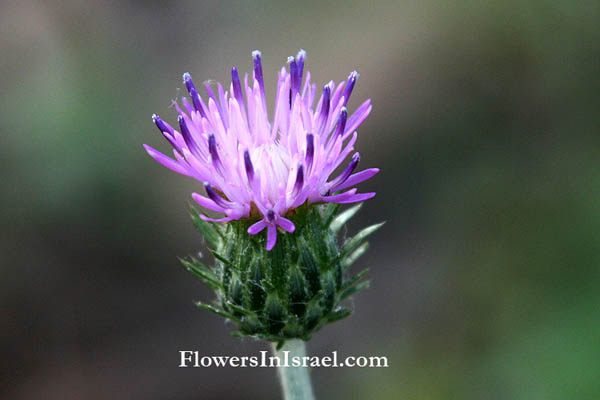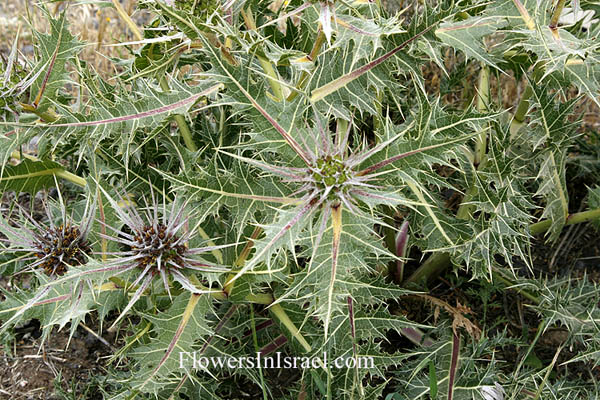It have been advised in a private email, which I am not at liberty

[Above (click to enlarge): Carduus argentatus, Silver Thistle: Flowers in Israel.]
to quote, that what the late Max Frei identified as Gundelia tournefortii pollen on the Shroud of Turin, had in 2001 been re-identified by a leading palynologist, Bonn University Prof. Thomas Litt, as within the different genus Carduus.
It was not possible for Prof. Litt to identify that Carduus genus pollen down to the species level, because Frei used sticky tape to take his samples off the Shroud  and then folded the tape over onto itself to preserve the pollen.
and then folded the tape over onto itself to preserve the pollen.
[Left: Max Frei using sticky tape to take pollen samples from the Shroud in 1978: Shroud.com]
But the tape glue has obscured the pollen's microstructure, which needs to be clearly seen under an electron microscope for a species-level identification.
The information itself in the email is not private, being in an 88-page book, Danin, A. & Guerra, H., 2008, "L'uomo della Sindone [Who is the Man in the Shroud?]," Edizioni ART: Rome, which however, as the title indicates, is in Italian. It is described in Google's translation as basically an interview with Israeli botanist Prof. Avinoam Danin:
In this book-interview, the expert botanist Prof. Avinoam Danin, a professor at the Hebrew University of Jerusalem, presents the latest results of his research regarding the Shroud. Prof. Danin says that the only place in the world where people could gather fresh shares of at least four species of plants found on the Shroud and place them on the body, which was wrapped in it, is the area between Jerusalem and Hebron, and the weeks between the months of March and April are the only time of year in eight of the plants are identified on the Shroud in the same flower.
However, this reclassification by Prof. Litt of Frei's Gundelia tournefortii pollen to the Carduus genus may be a blessing in disguise for the authenticity of the Shroud. That is because there is a species in that genus, Carduus argentatus, which grows around Jerusalem, flowers in April-May, has a more attractive flower (see above), and is a much less thorny plant than Gundelia tournefortii.

[Above (click to enlarge): Gundelia tournefortii, Flowers in Israel. "an extremely fearsome-looking thorn ... it is certainly not obvious as the kind of plant that might have been used as a funerary bouquet," Ian Wilson (see below). ]
And most significantly, Frei did not identify any Carduus argentatus on the Shroud (see below). As can be seen, the only

[Above (click to enlarge): Part of a list of pollen species identified by Frei, in Bulst, W., "The pollen grains on the Shroud of Turin," Shroud Spectrum International, Vol. 3, No. 10, March 1984, pp.20-28].
Carduus species of pollen that Frei identified was Carduus personata, which however, although the above list does not indicate it, is a European plant.
Moreover, images of "plants from the Carduus genus of thistles" have been identified by Prof. Danin on the Shroud:
"Avinoam Danin, emeritus professor of botany at the Hebrew University of Jerusalem, has spent years examining images of plant life discovered on the shroud. He also has discovered additional pieces of plant life on the cloth, which has provided additional evidence to support his theory that the shroud was used somewhere in the area of Jerusalem. Over the years, Danin, co-author of `Flora of the Shroud of Turin,' noted he has discovered the presence of three plant species that indicate the shroud's origin was somewhere between Jerusalem and Hebron. Eight species also have been used to determine, through flowering characteristics, that the plant life placed on the body happened somewhere during March or April. Danin said he also recently has indicated more than 300 flowers and plant parts on the head area of the shroud. Those were discovered, he said, after studying photos of the cloth taken in the 1970s.Among the plant life identified are the Matricaria and Anthemis, two genera of the sunflower family. He also said he discovered plants from the Carduus genus of thistles, and pieces of the shrub Rhamnus lycioides - both potential evidence of a crown or helmet of thorns." (Brinker, J., "Plant life traces on Shroud of Turin draws local interest," St.Louis Review, September 5, 2008.).
including apparently Carduus argentatus:
"Capparis [sic] argentatus is one of the flower images identified on the Shroud by Avinoam Danin, a botany professor at the Hebrew University of Jerusalem and a leading authority on the flora of Israel, along with Uri Baruch, a pollen specialist with the Israel Antiquities Authority. The identifications of Carduus Argentatus confirmed some previous floral image identifications by Oswald Sheuermann, a German physicist, and Alan Whanger, a professor at Duke University." ("Carduus argentatus flower image," Sugar Coated Shroud of Turin, 2 September 2008),
although I have yet to find where Danin himself has claimed that particular identification at the species level.
And as Ian Wilson pointed out, there is a problem of why pollen of a not particularly pretty flowered, or pleasantly scented, and very thorny species like Gundelia tournefortii was in such abundance on the Shroud, because "it is certainly not obvious as the kind of plant that might have been used as a funerary bouquet":
"All of this raises the question of just what sort of plant is Gundelia tournefortii? At which point the surprise is that it is an extremely fearsome-looking thorn, with prickly leaves and a thistle-like head that bears the sharpest of spines. Its greatest known usefulness appears to be as a low-grade winter fodder for goats and sheep when there is nothing better available for them. So it is certainly not obvious as the kind of plant that might have been used as a funerary bouquet, even supposing there was evidence that the Jews of Jesus' time had such a custom. Likewise, while it is possible that the plant's spikiness might have caused it to be used for the `crown of thorns' laid on Jesus' head - a view certainly favoured by Dr Alan Whanger - Danin for one is ambivalent on this. And Dr Fred Zugibe, having carefully compared photos of Gundelia with the bloodstains around the back of the Shroud man's head, similarly expresses doubts. In fact the very distribution of Gundelia pollen grains as these occur on the Shroud is contra-indicative of any such scenario. The greatest concentration of specimens (fourteen) has been found on tape 4/3Aa, which Frei took from the very edge of the Shroud's front-of-the-body half, at the level of the crossed hands, with the next highest incidence ten specimens on tape 12 Cd, from the spillage of blood from the ankle on the back-of-the-body half of the cloth. Conversely only a few Gundelia have been found in the region of the head. ... But while it might resolve matters wonderfully if we knew Gundelia to have some perfuming or fumigatory properties, its odour is said to be very nondescript, the closest resemblance being artichoke." (Wilson, I. & Schwortz, B., "The Turin Shroud: The Illustrated Evidence," Michael O'Mara Books: London, 2000, pp.90-91).
So if Frei was wrong in his identification of Gundelia tournefortii pollen (as seems to be the case) and it is actually Carduus argentatus, then that would seem to be even better for the Shroud's authenticity, given that C. argentatus would be a much more likely flower for Jesus' disciples to place on His body as a funerary bouquet than G. tournefortii.
I look forward to an eventual (perhaps in conjunction with the next Shroud exhibition in 2010?) new extraction and identification of pollens directly from the Shroud, i.e. that are not from the Frei collection and so have not been embedded in obscuring sticky tape glue.
PS: It has just occurred to me (January 27, 2010) that there is a second blessing in disguise if this is an error in classification by Frei, in that it would be evidence against claims by Schafersman and others that Frei's data was fraudulent. That is because if Frei did collect modern pollen and claim it was Gundelia tournefortii he would have collected it from that species as an easily identifiable living plant. There was also no reason for Frei to choose Gundelia tournefortii because as my quote by Wilson indicated, it is an unlikely plant to be used in a 1st century Jewish burial.
Posted: 26 November 2008. Updated: 29 August 2017.
Mr. Jones,
ReplyDeleteprof. Danin quotes in his last book prof. Litt sayng: "I cannot make a precise identification of the pollen at the genus level, even less at the species level. However, with a high level of probablility, I can exclude that the pollen I have seen from the sticky tapes belong to Gundelia.".
but from your post I understand that prof. Litt made indeed an indentification at the genus level (cardus) even if he has previously said it was not possible..
So, prof. Litt has changed his mind?
domenico
ReplyDelete>Mr. Jones
Thanks for your comment and apologies for my delay in replying. I am now on holidays from almost full-time work as a relief (aka substitute or supply) teacher, so I can begin to catch up with my blogging.
>prof. Danin quotes in his last book prof. Litt sayng: "I cannot make a precise identification of the pollen at the genus level, even less at the species level. However, with a high level of probablility, I can exclude that the pollen I have seen from the sticky tapes belong to Gundelia."
I have seen that quoted elsewhere, e.g. on the Shroud of Turin Blog and The Definitive Shroud of Turin FAQ, but from memory I have not posted it myself, although I do have it in a copy of a private email between Prof. Danin and another person:
"In his report to CSST Prof. Litt wrote: `The images produced by light microscopy (interference contrast) and by confocal laser-scanning microscopy show clearly that waxes are preserved and cover the structure and sculpture of the pollen grains. This is the reason why I cannot make a precise identification of the pollen at the genus level, even less at the species level. However, with a high probability, I can exclude that the pollen, I have seen on the sticky tapes, belong to Gundelia.'"
>but from your post I understand that prof. Litt made indeed an indentification at the genus level (cardus) even if he has previously said it was not possible. So, prof. Litt has changed his mind?
I don't know whether Prof. Litt has changed his mind. In the same email Prof. Danin wrote:
"In the summer of 2001, I informed Dr. Whanger of the results of the pollen analysis carried out by Prof. Dr. T. Litt in Bonn; I told him that what was considered earlier as Gundelia tournefortii got a lower grading and fell into the `box' of Carduus type."
Probably the key to this apparent contradiction is the word "precise." That is, Prof. Litt was able to tentatively identify what Frei thought was the pollen of Gundelia tournefortii as being of the genus Carduus, without being able to conclusively identify it as such.
Stephen